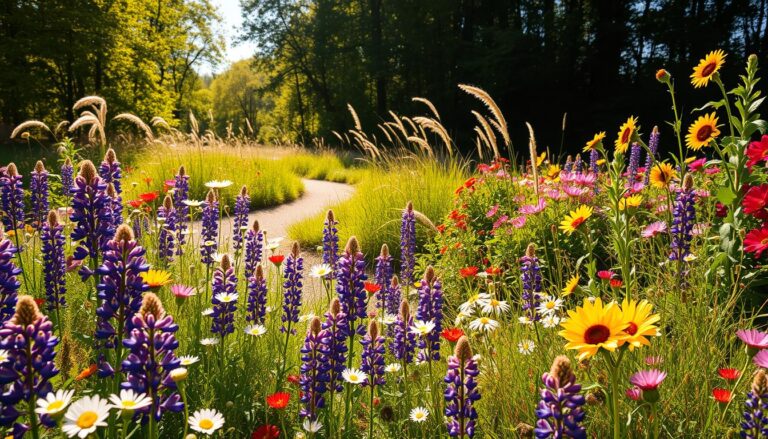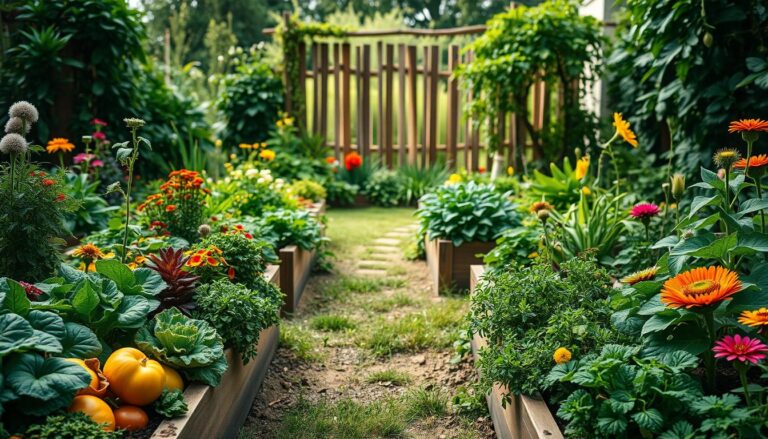Inspiring Garden Layout Designs to Transform Your Backyard
This post contains affiliate links, meaning I may receive a small commission if you make a purchase through my links, at no extra cost to you.
As you step into your outdoor space, you dream of a peaceful oasis that shows off your style. Gardening became more popular during the COVID-19 pandemic. Now, making your backyard beautiful and useful is a big goal.
A well-designed backyard garden can be a place for calm, fun, and connecting with nature.
You can turn your outdoor area into a beautiful retreat with the right garden ideas. Whether you like modern or traditional, there’s a garden layout design for you. In this article, we’ll look at inspiring garden designs and ideas to make your backyard dream come true.
Key Takeaways
- Discover the latest trends in backyard garden design
- Learn how to create a functional and beautiful outdoor space
- Explore different garden layout designs to suit your style
- Get inspiration from real-life examples of transformed backyards
- Find tips on how to maintain your backyard garden
Understanding the Basics of Garden Layout Designs
To turn your backyard into a paradise, you need to grasp the basics of garden layouts. A well-thought-out garden is not just pretty; it’s also practical and eco-friendly. Think about the space you have and how to use it wisely.
The Importance of Planning Your Garden
Planning is key for a successful garden. It helps you decide what your garden is for, like relaxation or growing food. A good plan makes your garden both stunning and useful. Experts say a well-planned garden can boost your home’s value and offer a peaceful retreat.
Henry Mitchell once said, “The garden is a love song, a duet between a human being and Mother Nature.” This quote shows how important it is to be in harmony with your garden’s natural beauty.
Different Types of Garden Layouts
There are many garden layouts to pick from, based on what you like and the space you have. Options include square-foot gardening, backyard layouts, and raised beds. Each style has its own perks and can be customized to fit your needs.
- Square-foot gardening is great for small areas, letting you grow many plants in a small space.
- Backyard garden layouts can include existing features like trees and slopes.
- Raised bed garden layouts help with drainage and soil quality, making it easier to grow various plants.
Common Mistakes to Avoid
When designing your garden, steer clear of common errors. Mistakes include not thinking about plant sizes, poor drainage, and not enough space for paths.
By knowing the basics of garden layouts and avoiding common mistakes, you can make a beautiful and useful garden. Whether you’re into small garden design or a bigger garden, aim for a space that’s both fun and eco-friendly.
Popular Garden Styles to Consider
Creating a beautiful garden is more than picking the right plants. It’s also about choosing a style that fits your taste. The style of your garden greatly affects the feel of your outdoor space. This makes it a key part of your backyard garden ideas. We’ll look at three popular garden styles for your garden.
Cottage Gardens: Charm and Abundance
Cottage gardens are full of charm and abundance. They mix flowers, herbs, and shrubs in an informal way. This creates a warm, welcoming space. To make a cottage garden, use plants with different textures and colors. Add whimsical touches like a garden bench or vintage statue.

Designing a cottage garden aims for abundance and charm. Use a mix of annuals and perennials. Add layers of planting, like groundcovers, shrubs, and trees.
Modern Gardens: Sleek and Minimalist
Modern gardens are sleek and minimalist. They have clean lines, simple shapes, and a few colors. For a modern garden, pick a few plants and use hardscaping like stone or wood for structure.
A modern garden is ideal for a zen garden backyard or japanese garden backyard. Use natural elements like gravel or stone. Choose plants with clean lines for a peaceful feel.
Xeriscaping: Water-Efficient Beauty
Xeriscaping focuses on saving water. It’s great for areas with little rain or for those who want to use less water. For a xeriscape garden, use drought-tolerant plants and efficient irrigation.
Xeriscaping is perfect for a beautiful garden that saves water. Use plants that thrive in dry conditions. This way, your garden looks stunning with little watering.
Elements of a Great Garden Layout
A well-designed garden layout is the key to a stunning outdoor space. It’s more than just picking the right plants. It’s about creating a space that looks good and works well.
Efficient Use of Space
Using space wisely is crucial, whether your garden is big or small. Think about vertical gardening or tiered planters to use every inch. For a small backyard garden design, choose plants that don’t spread out too much.

Also, think about the paths in your garden. Make sure they’re wide enough for easy walking. Design them to show off the garden’s best parts.
Harmony Between Planting and Pathways
It’s important for plants and paths to work together. Choose plants and paths that look good together. For example, winding paths can take visitors on a tour of your garden.
When picking plants, think about their size and how they’ll fit with the paths. Garden landscaping ideas layout often mix different textures and colors for interest.
Incorporating Focal Points
Focal points are key in a garden, as they catch the eye and add interest. These can be big plants, water features, or sculptures. Think about how these elements will look from different places in your garden.
By using space well, matching plants and paths, and adding focal points, you can make a garden that’s beautiful and fun to use.
Budget-Friendly Garden Layout Designs
Creating a beautiful garden doesn’t have to be expensive. There are many budget-friendly designs to explore. You can turn your outdoor space into a lovely retreat with clever, cost-effective ideas.
Creative DIY Solutions
DIY solutions are a great way to save money on your garden. You can use old materials like wooden pallets, bricks, or stones for unique features. For instance, an old pallet can become a vertical garden or a planter box.
You can also make DIY trellises from twine and wooden stakes. These support climbing plants.

Choosing Affordable Plants
Choosing the right plants can greatly affect your budget. Native plants are often cheaper and need less care. Plants in season are also less expensive than exotic ones.
Perennials are a smart choice too. They come back every year, saving you from replanting often.
| Plant Type | Cost | Maintenance |
|---|---|---|
| Native Plants | Low | Low |
| Perennials | Moderate | Low |
| Exotic Plants | High | High |
Repurposing Materials
Repurposing materials is both budget-friendly and eco-friendly. Old containers, tubs, or even bathtubs can become planters. You can also use recycled materials like glass bottles or cans for decorative elements or plant markers.
By using these budget-friendly ideas, you can create a beautiful garden without spending a lot. Whether you have a small backyard or a large patio, there are many ways to enhance your garden on a budget.
Flower Bed Layout Ideas
Turning your backyard into a vibrant oasis starts with creative flower bed layouts. A well-designed flower garden can be the centerpiece of your outdoor space. It provides a beautiful display of colors and textures all year.

When designing your flower bed, you can choose between symmetrical and asymmetrical layouts. Symmetrical designs offer a sense of order and balance. They feature mirrored patterns on either side of a central axis. On the other hand, asymmetrical designs create a more dynamic and interesting landscape. They use different shapes and sizes.
Symmetrical vs. Asymmetrical Designs
Symmetrical flower bed layouts are ideal for formal gardens. They emphasize precision and order. You can achieve them by dividing the bed into equal parts and planting the same flowers on either side.
Asymmetrical designs, however, are perfect for creating a more natural, relaxed atmosphere. They allow for greater flexibility and creativity in your flower garden.
Layering Plants for Visual Interest
Layering plants of different heights and textures is crucial for visual interest in your flower bed. Start with a base layer of low-growing plants. Then, add mid-height flowers, and finish with taller plants or shrubs.
This layering technique adds depth and dimension to your garden. It makes your garden more engaging and beautiful.
Seasonal Blooms: Planning for Year-Round Color
To keep your flower garden vibrant all year, plan for seasonal blooms. Choose a mix of plants that flower at different times. This includes spring bulbs, summer perennials, and fall asters.
For example, start with spring-blooming flowers like tulips and daffodils. Then, add summer flowers like sunflowers and zinnias. In the fall, asters and chrysanthemums can add a burst of color. Winter interest can be achieved with evergreen shrubs and holly.
Designing Multi-Functional Spaces
Think about making your backyard a place that does more than one thing. A good garden can make your outdoor space look better and be useful for different activities.
One smart way to do this is by adding different parts to your garden. For example, you can make a backyard vegetable garden design that looks good and gives you fresh food.
Vegetable and Herb Gardens
Having a vegetable and herb garden in your backyard means you can always have fresh food ready. Use raised beds or containers for growing a variety of veggies and herbs. This makes your garden useful and smells nice too.
Some good things to grow in your garden include:
- Tomatoes and peppers
- Herbs like basil and rosemary
- Leafy greens like lettuce and kale
When planning your garden, think about how much sun and water your plants need. You can also use companion planting to help your plants grow better and fight off pests.
Relaxation Areas and Seating
It’s also important to have places to relax and sit in your backyard. You can add outdoor furniture like benches, hammocks, or pergolas. Make sure the furniture fits with your garden’s look.
Here are some ideas for relaxing spots:
- Make a cozy reading spot with a comfy chair and a side table
- Build a pergola with climbing plants for shade
- Add a water feature, like a small pond or fountain, for a calming sound
Think about what views and sounds you want in your relaxation area. You can also add lights to use the space later in the day.
Play Zones for Kids
If you have kids, you’ll want a play area that’s fun and safe. Add play equipment like swings, slides, or climbing walls to your garden. You can also make a play area with soft flooring and safety features.
Here are some play area ideas:
- Make a sandbox or mud pit for creative play
- Add a mini trampoline or bounce house
- Build a climbing wall or rock climbing structure
When planning your play area, think about your kids’ age and abilities. Make sure the equipment is safe and sturdy.

By adding different spaces to your garden, you can make a beautiful and useful outdoor area for your family. Whether you’re looking for garden ideas backyard or small backyard garden ideas, there are many ways to improve your outdoor space.
| Multi-Functional Space | Benefits |
|---|---|
| Vegetable and Herb Gardens | Fresh produce, aesthetic appeal |
| Relaxation Areas and Seating | Stress relief, socializing |
| Play Zones for Kids | Fun, safety, development |
“A garden is a love song, a duet between a human being and Mother Nature.” – Jeff Cox
Utilizing Vertical Space in Garden Layouts
Make your patio gardening better by using vertical space. In small backyards, using all available space is key. Adding vertical elements to your garden design is a smart move.
Vertical gardening saves space and looks great. It adds depth and interest to your outdoor area. Use walls, fences, or other structures to create a lush garden in tight spaces.
Vertical Gardening Techniques
There are many ways to make a vertical garden. You can use trellises or arbors for climbing plants like ivy or roses. Or, try wall-mounted planters or living walls to fit your space.
Think about sunlight, plant types, and look when picking a method. For shaded areas, choose plants like ferns or impatiens.

Using Trellises and Arbors
Trellises and arbors are great for gardens. They support climbing plants and add beauty. Pick one that matches your garden’s style and size.
| Type | Material | Best for |
|---|---|---|
| Trellis | Wood or Metal | Climbing plants like roses or clematis |
| Arbor | Wood or Vinyl | Creating a garden entrance or focal point |
Hanging Planters for Small Spaces
Hanging planters are perfect for vertical gardening. Hang them from trees or your house to add greenery. Choose planters based on weight, material, and drainage for healthy plants.
Look for baskets from natural materials or durable plastics. Hanging planters make your garden look good and work well in small spaces.
Enhancing Privacy with Garden Design
You can make your garden more private with a few simple changes. A private garden is not just a luxury; it’s essential for many. It creates a calm and peaceful space.
Strategic Placement of Trees and Shrubs
Placing trees and shrubs wisely can greatly improve privacy. Dense foliage blocks unwanted views and acts as a natural barrier. Plant trees or shrubs around your garden’s edges for a secluded feel.

Choose trees and shrubs based on their size, growth, and density. Evergreen plants offer privacy all year. Deciduous plants add seasonal interest.
Creating Natural Barriers
You can also use hedges or bamboo screens as natural barriers. They block views and add seclusion. Use plants native to your area for the best results.
Think about the look you want for your barrier. You can go for a formal or informal style, matching your garden’s design.
Using Fences and Screens
Fences and screens boost privacy and add interest. Choose a fence design that fits your garden’s style, like wood or metal. Screens can block views or separate garden areas.
Consider the material, height, and style of fences and screens. You can pick from wood, metal, or vinyl. Choose a height that meets your needs.
Tips for Maintaining Your Garden Layout
Keeping your garden looking good and working well all year is key. To do this, you need to do seasonal upkeep, water and fertilize regularly, and change things up when needed.
Seasonal Maintenance Tasks
Every season has its own garden care needs. In spring, you should prune and clean up. Summer means watering and mowing often. Autumn is for leaf cleanup and winter prep. Winter calls for protecting plants from cold.
Routine Watering and Fertilizing
Watering and fertilizing right is crucial for your garden’s health. Water deeply but not too often to help roots grow deep. Fertilize based on what your plants need, using organic or chemical options.
Adapting Your Layout Over Time
As your garden grows, you might need to tweak your design. Be ready to move or prune plants, add new elements, or change the layout to keep it looking great.
By following these tips, you can have a beautiful and lively garden. It will add joy and peace to your outdoor space, no matter the size.
FAQ
What is the importance of planning in garden layout design?
Planning is key in garden design. It makes your garden look good and work well. A good plan helps you use your space wisely and balance different parts of your garden.
What are some common mistakes to avoid in garden layout design?
Don’t forget to think about how big plants will get. Make sure you have enough room for paths. And don’t forget to add special points in your garden.
Also, plan for the seasons and keep your garden up. This will help avoid a messy garden.
What are some popular garden styles that I can consider for my backyard?
You can choose from cottage, modern, or xeriscaping gardens. Cottage gardens are full of flowers and feel cozy. Modern gardens are simple and clean.
Xeriscaping saves water and is great for dry areas.
How can I create a beautiful flower bed?
Mix up your design with symmetry and asymmetry. Layer plants for interest. Plan for flowers that bloom at different times.
Use plants with different textures and colors. This adds depth and beauty.
How can I enhance privacy in my garden design?
Use trees and shrubs to block views. Create natural barriers. Fences and screens also work well.
Try vertical gardening with trellises and arbors. This makes a private area.
What are some budget-friendly garden layout design ideas?
Use DIY projects and affordable plants. Repurpose materials to save money. Vertical gardening and hanging planters are also good choices.
How can I maintain my garden layout over time?
Do seasonal tasks like pruning and fertilizing. Water regularly. Be ready to change your layout as plants grow.
What are some tips for designing multi-functional spaces in my garden?
Add vegetable and herb gardens, places to relax, and areas for kids. Use vertical gardening and hanging planters to save space.
How can I utilize vertical space in my garden layout?
Use trellises, arbors, and hanging planters for vertical gardening. Wall-mounted planters and other space-saving ideas also work well.
What are some elements of a great garden layout?
A good garden uses space well and balances plants and paths. Add focal points and use plants with different textures and colors.







